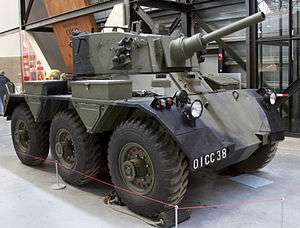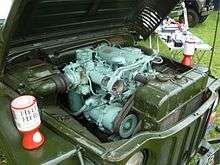Rolls-Royce B range engines
The Rolls-Royce B range was a range of petrol engines first intended to be installed in a car but in 1943 developed into a range to power the British Army's wheeled vehicles.[1]
The Alvis Saladin and Rolls-Royce Phantom IV were fitted with 8-cylinder versions.

Overview

Common Features
The B range of engines were all of the inline configuration, with crossflow inlet-over-exhaust cylinder heads and were naturally aspirated. They were heavily rationalized engines, which made use of as many common parts across the range as possible, for example, the 8 cylinder versions used 2 sets of the oil bath air filters, exhaust manifolds and points components of the 4 cylinder, while using the same carburettor as the 6. Pistons, rods, valves, springs, liners, etc. were common across the range, until the introduction of the overbored xx1 series, which still attempted to use as many common components as possible.
The engines were designed to produce relatively high power outputs (for the time), while being extremely reliable and running on low grade "pool" petrol. They were designed to be simple to maintain, with washable oil and fuel filters, mechanical fuel pumps and could all be started via a hand crank.
Models
The engines were available in 5 main models, which were fitted to small to medium tactical vehicles, up to about 13 tonnes in mass. They were also used in some fixed and mobile plant equipment.
| Model | Configuration | Displacement | Power Output | Redline | Bore | Stroke | Produced (approx.) | Applications |
|---|---|---|---|---|---|---|---|---|
| B40 | I4 | 2838 cc | 80 bhp | 3750 rpm | 3.5" | 4.5" | 20,000 | Austin Champ, 10kW trailer-mounted Generators, Coles crane. |
| B60 | I6 | 4256 cc | 120 bhp | 3750 rpm | 3.5" | 4.5" | 14,500 | Daimler Ferret, Humber 1 Ton, Humber Pig, Humber Hornet |
| B61 | I6 | 4887 cc | 140 bhp | 3750 rpm | 3.75" | 4.5" | ||
| B80 | I8 | 5675 cc | 160 bhp | 3750 rpm | 3.5" | 4.5" | 4,700 | Alvis Saracen, Alvis Saladin, Alvis Salamander, Centurion ARV Winch Motor, Douglas Aircraft Tug |
| B81 | I8 | 6516 cc | 185 bhp | 3750 rpm | 3.75" | 4.5" | 4,000 | Alvis Stalwart, FV430 Series (Mk 1) |
Marks
The engines were manufactured in 8 marks. For example, the Daimler Ferret was fitted with the B60 Mk 3A in early production and the B60 Mk 6A in the later production examples. The table below details the main differences between the marks, but there were also minor differences, such as changes to pulley configurations and accessories as well. Depending on the fitment of the engine, different accessories may also be installed so, for example, a B80 Mk 6A from an Alvis Saracen is not directly interchangeable with a B80 Mk 6A from an Alvis Saladin, as the Saladin is fitted with a high output 70A generator, and has different mounts for the engine, water piping, accessories and hydraulic system.
| Mark | Threads | Head | Block | Sump | Compression | Min. Fuel Requirement | Notes |
|---|---|---|---|---|---|---|---|
| Mk 1 | B.S.F. | 80 RON | Prototype only | ||||
| Mk 2 | B.S.F. | Alloy | Iron | Wet | 6.4:1 | 80 RON | |
| Mk 3 | B.S.F. | Alloy | Iron | Dry | 6.4:1 | 80 RON | |
| Mk 4 | B.S.F. | Alloy | Alloy | Wet | 6.4:1 | 80 RON | Prototype only |
| Mk 5 | U.N.F. | Iron | Iron | Wet | 6.4:1 | 80 RON | |
| Mk 6 | U.N.F. | Iron | Iron | Dry | 6.4:1 | 80 RON | |
| Mk 7 | U.N.F. | Iron | Iron | Wet | 7.25:1 | 86 RON | |
| Mk 8 | U.N.F. | Iron | Iron | Dry | 7.25:1 | 86 RON |
History
The group of engineers at Rolls-Royce's Clan Foundry in Belper Derbyshire led by W A Robotham completed development of the Rolls-Royce Meteor engine in 1943 and began work on this rationalised range of petrol engines to power a range of army combat vehicles. Development was completed and manufacture started at Rolls-Royce Crewe in 1947.[2]
B40 engines were required in large numbers for the British Army contract to build 15,000 ¼ton "Champs" over four years (1951-1956) plus spare engines and parts, and a further 400 vehicles for the Australian Army. Rolls Royce were unable to cope with production at this rate and the Austin Motor Co were granted a licence to produce B40 Mk.5A engines, and also loaned tooling. The majority of Champs produced were fitted with Austin-built engines which are identified by 5-digit serial numbers.
Modern Usage
Due to the popularity of 1950s and 1960s British Military vehicles with collectors, many Rolls-Royce B range engines are still in use.
- The original MOD specification called for the use of OMD-110 oil, which has a civilian equivalent rating of a straight 30W detergent mineral motor oil. A later specification substituted a 10W30 and some owners use a 20W50 without problems. In any case, owners need to ensure that the oil is compatible with yellow and white metals used in the engine.
- Due to their low compression ratios and hardened valve seats, the B range of engines are suitable for use with unleaded fuel, without modification.[3]
See also
References
- Rolls-Royce Motors Holdings Limited. The Times, Monday, May 07, 1973; pg. 23; Issue 58775
- Spencer MBE CEng FIEE, Reginald J. "Rolls-Royce at Clan Foundry, Belper". Rolls-Royce Enthusiasts Club. R.R.E.C Limited. A company registered in England and Wales, No 1154113. Retrieved 25 January 2017.
- Service Bulletin JGH/WAD, Rolls-Royce Motor Cars Limited, Crewe, 1989, p. 1
Bibliography
| Wikimedia Commons has media related to Rolls-Royce B series engines. |
- Munro, Bill (2002). Alvis Saracen Family. Ramsbury, England: The Crowood Press Ltd. ISBN 1-86126-537-9.CS1 maint: ref=harv (link)
- Ware, Pat (1994). In National Service. Warehouse Publications. ISBN 0-9525563-0-8.CS1 maint: ref=harv (link)